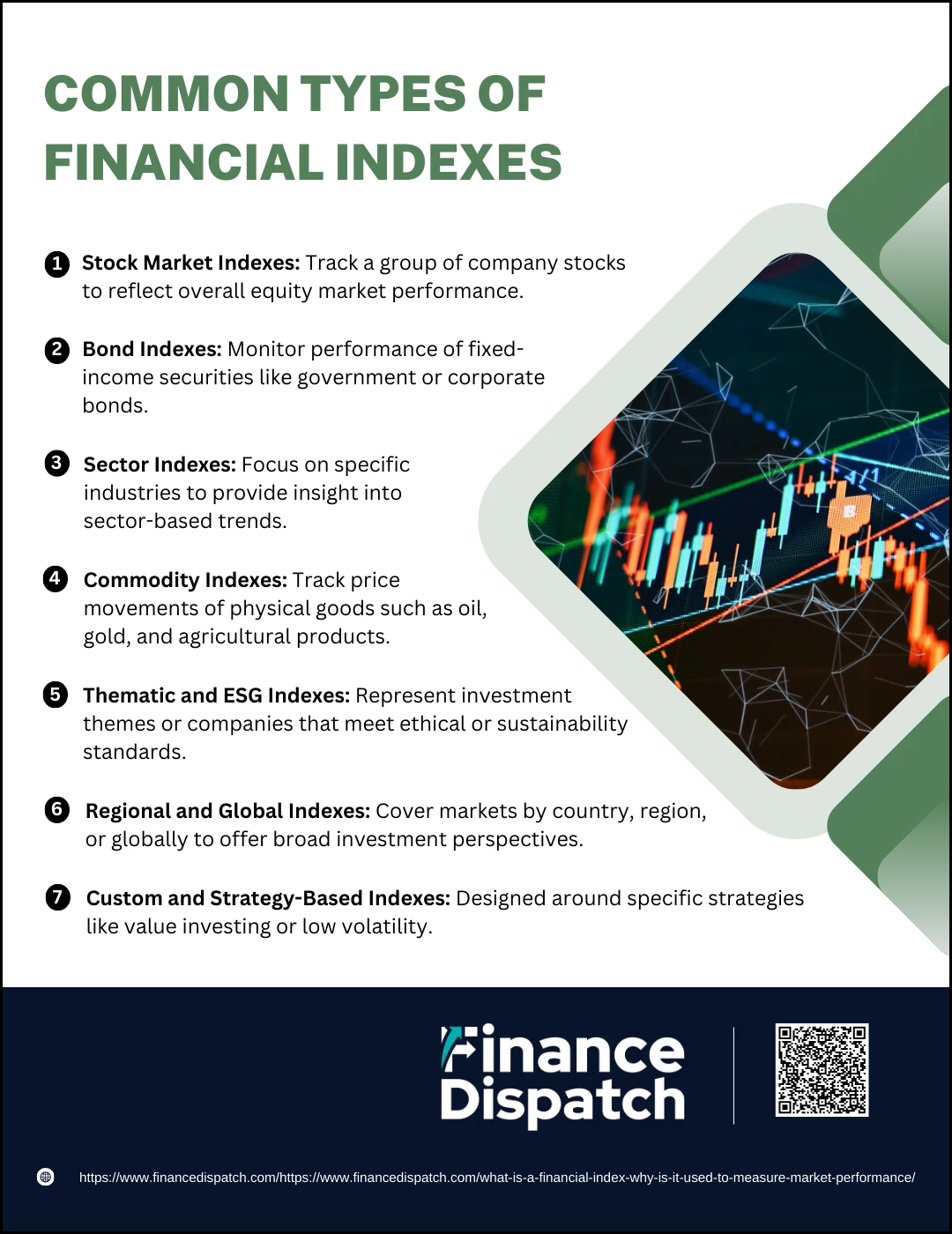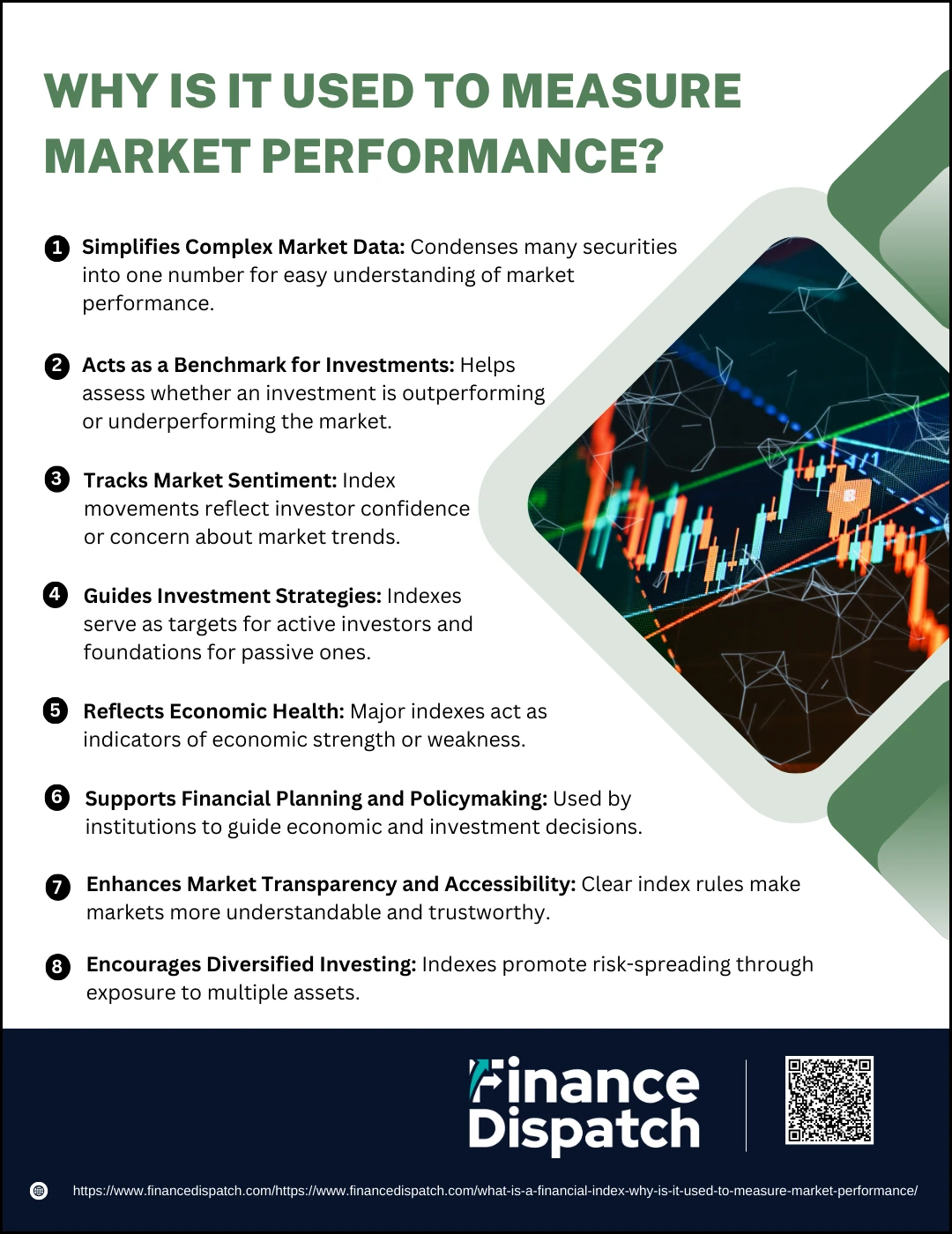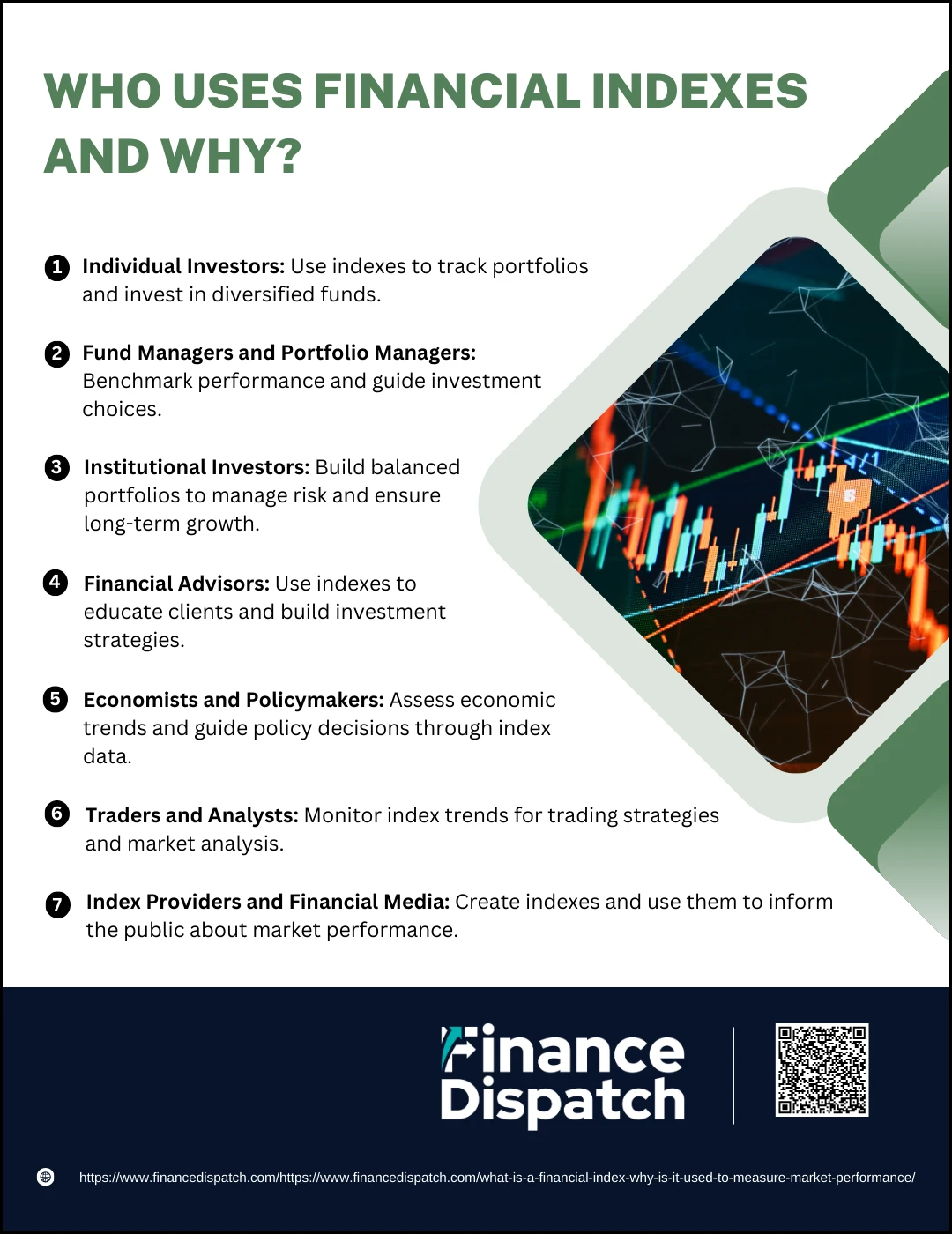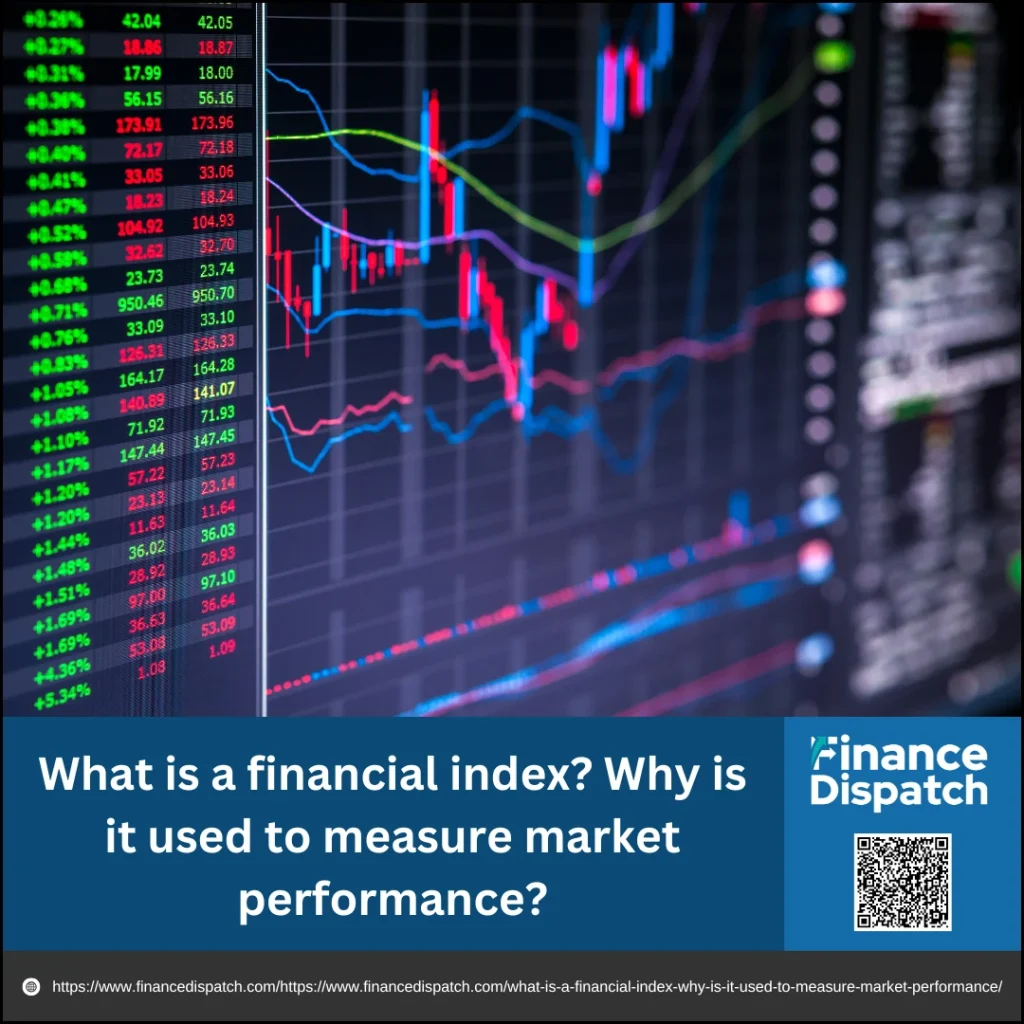If you’ve ever heard phrases like “the S&P 500 hit a new high” or “markets fell after the Dow dropped 300 points,” you’re already somewhat familiar with the concept of a financial index—even if you didn’t realize it. A financial index is one of the most important tools used to understand how markets are performing. It acts like a scorecard for a specific set of investments, helping you and other investors quickly grasp the health and direction of the market. Whether you’re tracking a country’s economic strength, comparing your portfolio’s performance, or looking for the right time to invest, understanding financial indices can give you the clarity and confidence you need to make smarter decisions. In this article, you’ll explore what a financial index is, how it works, and why it’s essential for measuring market performance.
What is a Financial Index?
A financial index is a statistical measure that represents the performance of a specific group of financial assets—such as stocks, bonds, or commodities—grouped together based on common characteristics. Think of it as a snapshot that reflects how a particular market or sector is doing at a given moment. For example, the S&P 500 tracks 500 of the largest publicly traded companies in the U.S., providing a broad view of the American stock market. These indices don’t hold any actual assets; instead, they serve as benchmarks to gauge overall trends. You can’t invest directly in an index, but you can invest in index-linked products that aim to mirror its movements. Whether you’re an individual investor or a financial analyst, a financial index gives you a reliable way to measure performance, track trends, and make informed decisions.
 How Does a Financial Index Work?
How Does a Financial Index Work?
A financial index works like a thermometer for the financial markets—it tells you whether the market (or a specific part of it) is heating up or cooling down. Instead of tracking individual stocks or bonds one by one, an index takes a group of them—called a “basket”—and calculates an average value that reflects their collective performance. This single number then moves up or down, depending on how the prices of the included assets change. It simplifies the complexity of the financial world into a manageable, easy-to-read figure you can use to monitor trends, compare investments, or guide your strategy.
Here’s a closer look at how it works, step by step:
1. Select the Components
The first step in building a financial index is deciding what goes into it. This selection is based on specific criteria such as company size, sector, location, or trading volume. For example, the S&P 500 includes 500 of the largest U.S. companies, while the NASDAQ-100 focuses on tech-heavy non-financial companies.
2. Determine the Weighting Method
Not every company in the index is treated equally. Different weighting methods determine how much influence each asset has on the overall index value.
-
- Market-cap weighted: Larger companies have more influence (e.g., S&P 500).
- Price-weighted: Companies with higher stock prices carry more weight (e.g., Dow Jones).
- Equal-weighted: Every company has the same impact, regardless of size or price.
3. Calculate Market Values
For indices using market-cap weighting, each company’s market capitalization is calculated by multiplying its stock price by the number of outstanding shares. These figures are essential for determining how much each company affects the index’s overall movement.
4. Apply the Index Formula
The index’s value is calculated by applying a specific formula that combines each asset’s price (and weight, if applicable). A divisor—essentially a smoothing number—is used to keep the index value consistent and comparable over time, especially after stock splits or other structural changes.
5. Rebalance Periodically
Markets don’t stand still—companies grow, shrink, merge, or get delisted. That’s why indices are reviewed regularly. The index provider may add new companies, remove outdated ones, or adjust weightings to ensure the index still accurately reflects its target market.
6. Monitor and Publish the Index Value
Once all the math is done, the index value is published—sometimes in real time (like the S&P 500) or at set intervals. This number becomes a widely watched market indicator used by investors, analysts, and the media to understand what’s happening in the financial world.
 Common Types of Financial Indexes
Common Types of Financial Indexes
Financial indexes come in many forms, each designed to track a specific area of the market. Whether you’re interested in stocks, bonds, sectors, or even themes like clean energy or technology, there’s likely an index that captures that space. Understanding the different types of indexes helps you choose the right benchmark or investment strategy based on your financial goals. Let’s explore the most common types of financial indexes and how they differ from one another.
1. Stock Market Indexes
These indexes track the performance of a group of stocks and are the most widely recognized. They can represent a specific exchange, country, or type of company. For example, the S&P 500 tracks 500 large U.S. companies, while the Dow Jones Industrial Average focuses on 30 blue-chip stocks.
2. Bond Indexes
Bond indexes track fixed-income securities such as government bonds, corporate bonds, and municipal bonds. They’re used to gauge the performance of the bond market and are commonly used by income-focused investors. Examples include the Bloomberg U.S. Aggregate Bond Index and the Citi World Government Bond Index.
3. Sector Indexes
These indexes are focused on specific industries or economic sectors, like healthcare, technology, or energy. If you want to track or invest in a particular sector, these indexes provide a more targeted approach. Examples include the NASDAQ Biotechnology Index and the S&P 500 Information Technology Index.
4. Commodity Indexes
Designed to measure the price movements of physical goods like oil, gold, agricultural products, and metals. The S&P GSCI (Goldman Sachs Commodity Index) is a well-known benchmark for global commodities.
5. Thematic and ESG Indexes
Thematic indexes focus on specific investment themes such as artificial intelligence, blockchain, or clean energy. ESG (Environmental, Social, and Governance) indexes include companies that meet certain sustainability or ethical criteria. These indexes appeal to investors looking to align their portfolios with their personal values.
6. Regional and Global Indexes
While some indexes focus on a single country, others cover entire regions or the global market. The MSCI World Index, for instance, includes stocks from 23 developed countries, offering a global perspective.
7. Custom and Strategy-Based Indexes
These indexes follow specific investment strategies or rules, such as value investing, low volatility, or dividend yield. Often used by institutional investors, these indexes can serve as the backbone for specialized ETFs and mutual funds.
 Why is it used to Measure Market Performance?
Why is it used to Measure Market Performance?
In the fast-moving world of finance, it’s essential to have a reliable, consistent way to measure how well the markets are doing. That’s exactly what a financial index provides. Rather than analyzing thousands of individual stocks or bonds, an index offers a streamlined snapshot of an entire market segment—whether it’s large-cap U.S. companies, tech stocks, government bonds, or emerging markets. These indexes allow you to see trends, compare results, and make informed decisions without getting overwhelmed by data. Here’s a closer look at why financial indexes are widely used to measure market performance:
1. Simplifies Complex Market Data
Financial markets are made up of countless securities, each with its own pricing and volume data. An index condenses this into a single value, giving you a simple way to understand how a market or sector is performing without needing to analyze every component individually.
2. Acts as a Benchmark for Investments
Whether you’re managing your own portfolio or working with a fund manager, you need something to measure performance against. That’s where indexes shine. If your investment is beating the index, you’re outperforming the market. If not, it’s a signal to adjust your strategy or allocation.
3. Tracks Market Sentiment
Index performance reflects how investors collectively feel about the market. A rising index typically means confidence in economic growth or earnings, while a falling index may suggest fear, uncertainty, or bearish outlooks. This insight into investor psychology is valuable for timing entries and exits.
4. Guides Investment Strategies
Indexes form the foundation for two main investment styles: passive and active investing. Passive investors buy index funds or ETFs to “own the market” with minimal cost and effort. Active investors use indexes as targets to beat, shaping their strategies around outperforming the benchmark.
5. Reflects Economic Health
Indexes like the S&P 500, FTSE 100, or Nikkei 225 are closely watched as proxies for national economies. A strong, steadily climbing index can suggest business growth, job creation, and rising consumer confidence, while a declining index may reflect economic contraction or instability.
6. Supports Financial Planning and Policymaking
Policymakers and institutions often rely on index performance to shape interest rate decisions, fiscal policies, and investment planning. For example, central banks may interpret market trends through index movement when deciding whether to stimulate or cool the economy.
7. Enhances Market Transparency and Accessibility
Indexes have clear rules for inclusion and weighting, which are publicly disclosed. This transparency builds trust in financial markets and allows retail investors to access the same performance data that institutional investors use.
8. Encourages Diversified Investing
Investing in an index fund automatically spreads your investment across dozens or hundreds of assets, reducing the risk that comes with betting on individual securities. Indexes give you exposure to the broader market with less volatility and fewer surprises.
Why Financial Indexes are Important
Financial indexes play a vital role in the world of investing and economic analysis. They offer a clear, concise way to measure the performance of a specific market or asset class, helping you make informed investment decisions without having to track every individual stock or bond. By acting as benchmarks, indexes allow you to evaluate how well your portfolio is doing compared to the broader market. They also provide insights into investor sentiment, market trends, and overall economic health. Whether you’re investing passively through index funds or actively managing your portfolio, indexes help you stay aligned with your financial goals. Their transparency, consistency, and wide coverage make them indispensable tools for individual investors, fund managers, analysts, and policymakers alike.
 Who Uses Financial Indexes and Why?
Who Uses Financial Indexes and Why?
Financial indexes aren’t just tools for professional traders—they’re used by a wide range of individuals and institutions across the financial world. From everyday investors to global policymakers, these indexes provide a common reference point for tracking performance, comparing results, and making decisions. Each user relies on indexes for different reasons, depending on their goals, strategies, and responsibilities. Here’s a breakdown of who uses financial indexes and why:
1. Individual Investors
You may use indexes to track how your investments are performing compared to the overall market. If you invest in index funds or ETFs, the goal is often to match the returns of a particular index like the S&P 500 or NASDAQ-100. Indexes also help you diversify and manage risk by providing broad market exposure.
2. Fund Managers and Portfolio Managers
Professional managers use indexes as benchmarks to evaluate their fund’s performance. Beating the index is often the goal for actively managed funds, while passive funds aim to replicate index performance. Indexes also guide asset allocation and sector exposure.
3. Institutional Investors
Pension funds, insurance companies, and endowments rely on financial indexes to construct diversified portfolios and reduce risk. These institutions often invest in products linked to major indexes to achieve stable, long-term returns.
4. Financial Advisors
Advisors use indexes to help clients understand market trends, compare investment options, and create personalized financial plans. Indexes provide a trusted framework for setting expectations and monitoring progress.
5. Economists and Policymakers
Government agencies and central banks monitor major indexes to assess the health of financial markets and the broader economy. Index performance can influence decisions on interest rates, monetary policy, and economic forecasts.
6. Traders and Analysts
Active traders use index data to identify trends, spot opportunities, and manage risk. Market analysts use index movements to make forecasts, publish reports, and guide investment recommendations.
7. Index Providers and Financial Media
Organizations like S&P Dow Jones, MSCI, and FTSE Russell design and maintain indexes. Financial news outlets rely on index movements to report market developments and shape headlines that influence investor behavior.
Can You Invest in a Financial Index?
While you can’t invest directly in a financial index—because it’s just a calculated number, not an actual asset—you can invest in financial products that are designed to track the performance of an index. These investment vehicles aim to replicate the returns of the index as closely as possible, giving you exposure to a wide range of assets without needing to buy each one individually. Here are the most common ways you can invest in a financial index:
- Index Funds
These are mutual funds that mirror the composition of a specific index, such as the S&P 500 or the FTSE 100. They offer a simple, hands-off approach to investing with relatively low fees. - Exchange-Traded Funds (ETFs)
ETFs function like index funds but trade on stock exchanges like regular stocks. They offer flexibility, liquidity, and tax efficiency, making them popular among both beginners and experienced investors. - Indexed Annuities
These are insurance products that provide returns linked to an index’s performance. They offer some level of downside protection while allowing for growth based on market trends. - Futures and Options on Indexes
For more advanced investors, index derivatives like futures and options allow you to speculate on or hedge against index movements, though they carry higher risk and complexity. - Closet Index Funds
These are actively managed funds that closely follow an index while charging higher fees. Though not ideal, they may still offer index-like exposure with slight strategic variations.
Conclusion
Financial indexes are much more than just market statistics—they’re essential tools that help you understand, measure, and navigate the financial world. Whether you’re investing for retirement, tracking economic trends, or comparing your portfolio’s performance, indexes provide a reliable and transparent benchmark. They simplify complex markets into understandable insights, offering a clear view of how different asset classes or sectors are performing. From individual investors to global institutions, the widespread use of financial indexes underscores their importance in decision-making, strategy development, and long-term planning. By understanding how they work and why they matter, you can make smarter, more confident financial choices.



